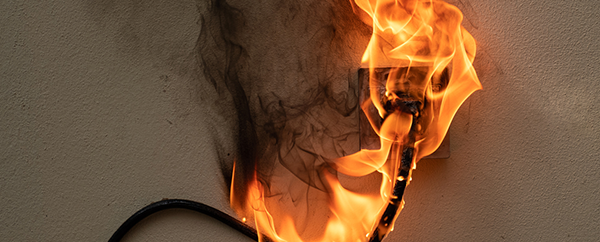Follow these steps to ensure your home electrical safety
- Each year 51,000 home electrical fires ignite. Arcing faults account for over half; electrical receptacles account for another 5,300.
- Electrical safety tips for new homeowners include having a qualified electrician inspect your entire system. For older homes, after an electrician’s inspection, ask where AFCI or GFCI receptacles should be added.
- View additional tips, from overloaded circuits and power strips or frayed cords to keeping clear of outdoor overhead lines and practicing a family evacuation plan.
Home electrical safety is crucial to prevent fires and injuries to everyone in your household. Home electrical fires account for an estimated 51,000 fires each year, nearly than 500 deaths, more than 1,400 injuries, and $1.3 billion in property damage. Not only are electrical fires common, but they also contribute to disproportionate rates of deaths and serious property damage.
Each year in the United States, arcing faults are responsible for starting more than 28,000 home fires, killing and injuring hundreds of people and causing over $700 million in property damage.
The U.S. Consumer Product Safety Commission (CPSC) reports that electrical receptacles alone are involved in 5,300 fires every year, causing 40 deaths and more than 100 consumer injuries.
Related: How to prevent home electrical fires
When proper precautions aren’t taken to preserve home electrical safety, fires that result from electrical malfunctions or accidents can be very dangerous. Add to that fact that 65 percent of home fire deaths result from fires in homes with no working smoke detectors.
Electrical distribution systems cause 48 percent of house electrical fires. They include such items as wiring, outlets, switches, chords and lightbulbs.
Electrical safety tips for new homeowners and older homes
- Have a qualified electrician inspect your home electrical system thoroughly to ensure that all electrical work in the home meets the NEC safety provisions.
- Ask your electrician if your home would benefit from AFCI (arc fault circuit interrupter) protection, especially during inspections of older homes or upgrades to electrical systems. These advanced new safety devices recognize dangerous conditions that are not detected by standard breakers to prevent fires.
- Or consider installing ground-fault circuit interrupters (GFCI) which sense current going to and from a device plugged into the wall. They basically shut down the power source if that current jumps its parameters (indicating a shock, for instance), to prevent shocks. Install these in bathrooms, kitchen, basement, laundry, garage and outdoor plugs.
- Install smoke detectors on every level of the home, both inside each bedroom and just outside and in common areas.
- Older homes often don’t have the capacity to handle today’s technology. Consider installing arc-fault circuit interrupters. CNET says they sense when electricity jumps from one wire to another. Regular arcing events occur when you flip on a light switch or plug your laptop charger. However, if it determines the situation is hazardous, it cuts power to prevent a fire from starting.
Related: Top homeowners risks (and tips on how to lower them)
Examine electrical items inside your home
- Assess the basics of your home electrical system, outlets, electrical cords, extension cords and power plugs.
- Check cords for any fraying, torn or exposed wiring. If you find an issue, shut off power via the circuit breaker. If it’s a small device, consider replacing it. For larger appliances, contact the manufacturer for tips on how to replace the cord. If it’s under warranty, they may replace it for you.
- Use light bulbs that match the recommended wattage on the light fixture. Don’t exceed the wattage.
- When inspecting an appliance, be sure to switch off the power to that appliance AND turn off the circuit breaker.
- Be aware of telltale signs of electrical problems such as dim and flickering lights, unusual sizzling and buzzing sounds from your electrical system and circuit breakers that trip repeatedly. Contact your qualified electrician immediately.
- Use extension cords only temporarily, and never with space heaters or air conditioners.
- Never use extension cords with larger appliances such as toaster ovens or microwaves.
- Don’t overload outlets; instead, consider having your electrician install additional circuits or outlets as needed.
Related: Space heater safety tips
Home electrical safety tips for outside
- Know where your electrical lines are. Keep ladders away from them when trimming trees or cleaning gutters.
- If lines are underground and you need to dig, contact your power company first.
Keep your family safe
- Test smoke detectors, GFCIs or AFCIs monthly to ensure they’re working properly.
- Create an evacuation plan to be used in case of an emergency and practice with your family.
- In homes with young children, install tamper-resistant receptacles to prevent electrical shocks and burns.
Related: How to eradicate fire hazards in your home
Resources
Electrical safety checklist
Home Electrical Fires
6 eye-opening and alarming statistics about electrical fires
Home Electrical Fires – NFPA

